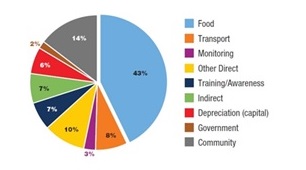When populations face multiple deprivations the demand for support services can be immense. This can result in multiple programmes being rolled out to support the same communities and sometimes the same ailments. Specifically in the context of schools, which provide an effective platform for multiple interventions, there is a paucity of evidence to support governments to design cost-effective integrated school health and nutrition programmes.
To fill this evidence gap an innovative 3 year research programme is being conducted by
Imperial College London’s Partnership for Child Development in partnership with the Government of Ethiopia to identify best practices in integrating multiple school health and nutrition interventions. The study focuses on the Enhanced School Health Initiative (ESHI), a school health and nutrition programme that integrates a home grown school feeding programme; Water, Sanitation and Hygiene (WASH); and deworming. The programme is being implemented in 30 schools in the Southern Nations, Nationalities and Peoples’ Republic Region of Ethiopia.
Analysis was conducted to ascertain if there were cost-efficiencies could be achieved by better integrating the three interventions.
The research shows that the combined cost of the three SHN interventions is US35.76 per child per year, with school feeding costing $US28.01 per children per year, WASH costing US$7.35 per year and deworming US$0.40 per year. The addition of WASH and deworming to the school feeding required an additional budget increment of 25%.
 |
| Total SHN Programming Costs equate to US$0.20 per child per day for a school year of 180 days. |
When the costs were broken down it was identified that monitoring and transport, which make up 14% of the total programming costs, had the greatest potential for efficiency savings. The analysis identifies that consolidating WASH and deworming transport requirements into school feeding transportation would save result in a saving of US$0.62 per child. If the programme adopted a single unified monitoring and evaluation framework for all the interventions a saving of US$0.75 per child could be achieved.
When combined these two efficiency savings added up to an overall cost reduction of 5.6%, applied to the 30 study school this equates to a saving of US$61,760. Extrapolated out to the whole SNNPR region just by integrating transport and monitoring for primary school SHN programmes would produce savings of $6,862,000.
The analysis shows that integrating just three interventions into SHN programmes has cost benefits and can be carried out efficiently.

